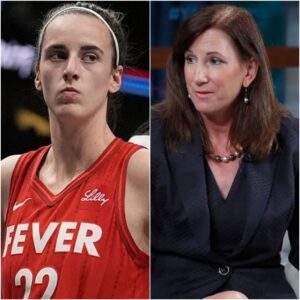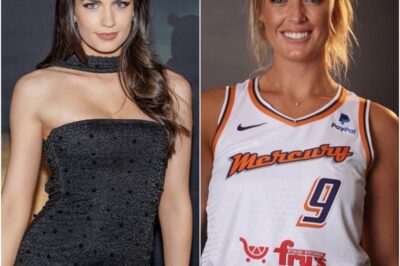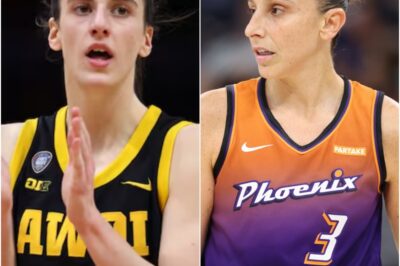BREAKING: Caitlin Clark Didn’t Just Boost Ratings — She Forced a Billion-Dollar Shift That’s Quietly Rewriting the Financial Future of the WNBA

For years, the WNBA was told to be patient.
“Your time will come.”
“Grow the game.”
“Keep grinding.”
For years, players boarded commercial flights while their NBA counterparts chartered jets. Salaries remained stagnant. Media coverage was spotty. And fans, however loyal, often had to explain — again and again — why women’s basketball deserved more.
Then came Caitlin Clark.
And now, everything is changing.
The Spark — And the Numbers Behind It
When the Indiana Fever selected Caitlin Clark with the No. 1 pick in the 2024 WNBA Draft, expectations were high.
No one expected this.
Clark has led the league in media impressions, accounting for over 30% of all WNBA-related content across digital platforms in the past year.
Game attendance has risen over 90% in cities where she plays.
National TV ratings are up 248% year-over-year.
Merchandise sales? Clark’s jersey broke every previous WNBA record within four weeks.
She’s not just a player. She’s a revenue stream.
And she’s made the entire country — and more importantly, the league’s executives and sponsors — take notice.
The $2.2 Billion Shift
In June 2025, the WNBA signed an 11-year, $2.2 billion media rights deal — doubling the size of its previous contract.
It was a seismic shift.
Commissioner Cathy Engelbert called it a “watershed moment,” a deal that would “reshape the economics of women’s professional sports.”
But for the players — especially those who paved the way long before Caitlin Clark arrived — the celebration was complicated.
Because while the money is growing, the distribution is not.
The Pay Gap at the Heart of the Storm
Consider this:
Clark’s rookie salary: $338,000 over four years
Her reported Nike deal: $150 million
Average WNBA salary: ~$130,000
Max WNBA salary: ~$250,000
Percentage of league revenue shared with players: under 10%
In the NBA, players split 50/50 with owners.
In the WNBA, that’s still a dream.
And for many players, it’s a line in the sand.
The CBA Showdown
The WNBA’s current collective bargaining agreement (CBA) expires in 2025.
This spring, the WNBPA — led by seasoned veterans and supported by rising stars — rejected the league’s initial extension proposal, calling it “tone-deaf” and “out of touch with the league’s present reality.”
Their demands:
Revenue sharing model closer to the NBA’s
Expanded rosters to accommodate league growth
First-class travel for all players
Increased playoff bonuses
Long-term healthcare and family benefits
Transparency in marketing allocations
“It’s not just about more money,” said one All-Star forward. “It’s about respect. About fairness. About not being told to be patient anymore.”
The Caitlin Conundrum
Here’s the irony:
Clark, who’s largely kept quiet during CBA talks, may be the biggest reason the league now has leverage — and the biggest reason tensions are rising.
She’s brought attention. Investment. Influence.
But she’s also become a symbol of disparity. Because while her endorsements are soaring, her teammates — the ones setting screens, taking hits, and sharing hotel rooms — are not seeing the same rewards.
And Clark knows it.
“I wouldn’t be here without the players who came before me,” she said recently. “If this is a moment of growth, it has to benefit everyone.”
That one sentence, spoken with signature calm, echoed louder than any three-pointer she’s hit this season.
The League’s Response — Too Little, or a Start?
In an effort to ease tensions and address the optics, the WNBA has introduced several short-term measures:
A new performance bonus pool funded by recent sponsorships
A broadcast revenue-linked equity plan for players with three or more years in the league
Veteran salary protections for teams expanding next season
Engelbert has also hinted at exploring “a more dynamic revenue-sharing model” — though specifics remain vague.
The reaction from players?
“Nice start,” one player said privately. “But don’t confuse that with structural change.”
Expansion, Influence, and the Road Ahead
What is clear: this is no longer a niche league.
The WNBA plans to expand from 12 to 14 or 16 teams by 2026, with serious conversations already happening in:
Philadelphia
Nashville
Toronto
Portland
These markets represent more than growth. They represent leverage.
More teams = more TV deals = more corporate interest = more pressure to modernize the league’s economic model.
And if the CBA negotiations succeed?
Average salaries could double or triple within two years.
Rookie deals could include equity clauses, not just flat contracts.
Player travel and healthcare could finally meet professional standards.
Why This Moment Matters
Let’s be honest: the WNBA has always had stars.
Lisa Leslie. Sue Bird. Diana Taurasi. Maya Moore. Candace Parker.
But never before has the league had a star with this much media capital, this early, in a moment where brands, fans, and digital platforms are all paying attention at once.
Clark may not want to be the center of a labor conversation — but her mere presence is changing the landscape.
“She made us impossible to ignore,” said one veteran player. “Now we’re making sure we’re not invisible inside our own league.”
Final Thought: The Spotlight Is Here. What the League Does With It Will Define Its Future.
This isn’t just about Caitlin Clark’s popularity.
It’s about what the league — and its leaders — do with the spotlight she helped create.
The WNBA can choose to be cautious, to make small adjustments and hope the moment lasts.
Or it can choose to build something bold — a league that doesn’t just grow, but transforms.
A league where visibility meets equity, where players are more than just symbols, and where the next Caitlin Clark earns millions — not just in commercials, but in her contract.
The next three months may shape the next three decades.
And for the first time, everyone is watching.
News
BREAKING: NBC Taps Maria Taylor For Major Role — Football Night Star Set To Dominate NBA & WNBA Studio Lineup Maria Taylor just scored a massive upgrade — after shining on Football Night in America, NBC’s making her the lead voice for both NBA and WNBA studio coverage. No more sidelines…
Maria Taylor (Credit: Kirby Lee-Imagn Images) NBC has announced a significant career update for popular “Sunday Night Football” host Maria…
FANS FURIOUS After Caitlin Clark’s Olympic Dream Gets Crushed By Diana Taurasi and Team USA Is Getting Torched Online
FANS FUMING AT TEAM USA After Caitlin Clark’s OLYMPIC SPOT GETS ROBBED By Diana Taurasi! “You’ve got to be kidding…
While filming Season 2 of The Pitt, Noah Wyle was hit with news so big, the cameras kept rolling — and captured his stunned reaction in real time. Cast and crew erupted as producers revealed a life-changing surprise that left Wyle speechless. What was supposed to be just another day on set turned into an unforgettable, emotional moment. Now fans are begging to know: what’s next for Wyle — and for The Pitt? (Watch the VIDEO!)……
The Pitt: Noah Wyle Receives Huge News While Filming Season 2 (VIDEO) HBO Max’s The Pitt posted a video of…
🚨 Netflix’s #1 Crime Hit Just Dropped a Jaw-Dropping Finale — And Fans Are Already Begging for Season 2 🔥 That ending? Absolutely wild. 😱 The top crime drama on Netflix just wrapped its explosive season with a twist no one saw coming — and now, fans are wondering if Season 2 is already in the works. Here’s everything we know so far… 👀👇
A daughter vanishes. A coastal empire crumbles. And behind every calm wave… something is rotting. It’s being called “Ozark with…
OMG Shocking !!! In a stunning turn of events at General Hospital, Willow regains her clarity and discovers that Drew has been orchestrating everything. She decides to take action by devising a counter-plan to have him incarcerated! What will be her initial step in this scheme?😱😱
OMG Shocking !!! In a stunning turn of events at General Hospital, Willow regains her clarity and discovers that Drew…
🎬Netflix’s Sinister New Crime Saga That’s Darker Than Ozark, More Addictive Than Your Wildest Binge, and Will Leave You Speechless!🔥 In the humid, salt-soaked air of coastal North Carolina, a new Netflix series has crashed onto screens with the force of a tidal wave, leaving viewers hooked, rattled, and begging for more. An eight-episode crime drama that premiered…
Netflix’s Sinister New Crime Saga That’s Darker Than Ozark, More Addictive Than Your Wildest Binge, and Will Leave You Speechless!…
End of content
No more pages to load












